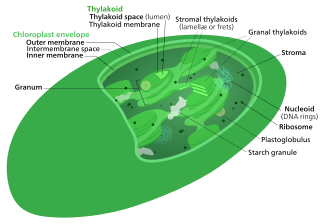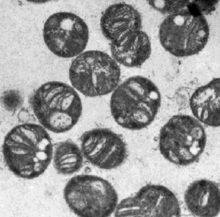
In biochemistry, chemosynthesis is the biological conversion of one or more carbon-containing molecules and nutrients into organic matter using the oxidation of inorganic compounds or ferrous ions as a source of energy, rather than sunlight, as in photosynthesis. Chemoautotrophs, organisms that obtain carbon from carbon dioxide through chemosynthesis, are phylogenetically diverse. Groups that include conspicuous or biogeochemically important taxa include the sulfur-oxidizing Gammaproteobacteria, the Campylobacterota, the Aquificota, the methanogenic archaea, and the neutrophilic iron-oxidizing bacteria.
The purple sulfur bacteria (PSB) are part of a group of Pseudomonadota capable of photosynthesis, collectively referred to as purple bacteria. They are anaerobic or microaerophilic, and are often found in stratified water environments including hot springs, stagnant water bodies, as well as microbial mats in intertidal zones. Unlike plants, algae, and cyanobacteria, purple sulfur bacteria do not use water as their reducing agent, and therefore do not produce oxygen. Instead, they can use sulfur in the form of sulfide, or thiosulfate (as well, some species can use H2, Fe2+, or NO2−) as the electron donor in their photosynthetic pathways. The sulfur is oxidized to produce granules of elemental sulfur. This, in turn, may be oxidized to form sulfuric acid.

The Calvin cycle,light-independent reactions, bio synthetic phase,dark reactions, or photosynthetic carbon reduction (PCR) cycle of photosynthesis is a series of chemical reactions that convert carbon dioxide and hydrogen-carrier compounds into glucose. The Calvin cycle is present in all photosynthetic eukaryotes and also many photosynthetic bacteria. In plants, these reactions occur in the stroma, the fluid-filled region of a chloroplast outside the thylakoid membranes. These reactions take the products of light-dependent reactions and perform further chemical processes on them. The Calvin cycle uses the chemical energy of ATP and reducing power of NADPH from the light dependent reactions to produce sugars for the plant to use. These substrates are used in a series of reduction-oxidation (redox) reactions to produce sugars in a step-wise process; there is no direct reaction that converts several molecules of CO2 to a sugar. There are three phases to the light-independent reactions, collectively called the Calvin cycle: carboxylation, reduction reactions, and ribulose 1,5-bisphosphate (RuBP) regeneration.
The Methylocystaceae are a family of bacteria that are capable of obtaining carbon and energy from methane. Such bacteria are called methanotrophs, and in particular the Methylocystaceae comprise the type II methanotrophs, which are structurally and biochemically distinct from the Methylococcaceae or type I methanotrophs.
Methanotrophs are prokaryotes that metabolize methane as their source of carbon and chemical energy. They are bacteria or archaea, can grow aerobically or anaerobically, and require single-carbon compounds to survive.
Methylotrophs are a diverse group of microorganisms that can use reduced one-carbon compounds, such as methanol or methane, as the carbon source for their growth; and multi-carbon compounds that contain no carbon-carbon bonds, such as dimethyl ether and dimethylamine. This group of microorganisms also includes those capable of assimilating reduced one-carbon compounds by way of carbon dioxide using the ribulose bisphosphate pathway. These organisms should not be confused with methanogens which on the contrary produce methane as a by-product from various one-carbon compounds such as carbon dioxide. Some methylotrophs can degrade the greenhouse gas methane, and in this case they are called methanotrophs. The abundance, purity, and low price of methanol compared to commonly used sugars make methylotrophs competent organisms for production of amino acids, vitamins, recombinant proteins, single-cell proteins, co-enzymes and cytochromes.
Denitrifying bacteria are a diverse group of bacteria that encompass many different phyla. This group of bacteria, together with denitrifying fungi and archaea, is capable of performing denitrification as part of the nitrogen cycle. Denitrification is performed by a variety of denitrifying bacteria that are widely distributed in soils and sediments and that use oxidized nitrogen compounds such as nitrate and nitrite in the absence of oxygen as a terminal electron acceptor. They metabolize nitrogenous compounds using various enzymes, including nitrate reductase (NAR), nitrite reductase (NIR), nitric oxide reductase (NOR) and nitrous oxide reductase (NOS), turning nitrogen oxides back to nitrogen gas or nitrous oxide.

Methane monooxygenase (MMO) is an enzyme capable of oxidizing the C-H bond in methane as well as other alkanes. Methane monooxygenase belongs to the class of oxidoreductase enzymes.
Microbial metabolism is the means by which a microbe obtains the energy and nutrients it needs to live and reproduce. Microbes use many different types of metabolic strategies and species can often be differentiated from each other based on metabolic characteristics. The specific metabolic properties of a microbe are the major factors in determining that microbe's ecological niche, and often allow for that microbe to be useful in industrial processes or responsible for biogeochemical cycles.
The formose reaction, discovered by Aleksandr Butlerov in 1861, and hence also known as the Butlerov reaction, involves the formation of sugars from formaldehyde. The term formose is a portmanteau of formaldehyde and aldose.

Gammaproteobacteria is a class of bacteria in the phylum Pseudomonadota. It contains about 250 genera, which makes it the most genus-rich taxon of the Prokaryotes. Several medically, ecologically, and scientifically important groups of bacteria belong to this class. It is composed by all Gram-negative microbes and is the most phylogenetically and physiologically diverse class of Proteobacteria.
Methylobacillus flagellatus is a species of aerobic bacteria.

In enzymology, a methanol dehydrogenase (MDH) is an enzyme that catalyzes the chemical reaction:
Methylocella silvestris is a bacterium from the genus Methylocella spp which are found in many acidic soils and wetlands. Historically, Methylocella silvestris was originally isolated from acidic forest soils in Germany, and it is described as Gram-negative, aerobic, non-pigmented, non-motile, rod-shaped and methane-oxidizing facultative methanotroph. As an aerobic methanotrophic bacteria, Methylocella spp use methane (CH4), and methanol as their main carbon and energy source, as well as multi compounds acetate, pyruvate, succinate, malate, and ethanol. They were known to survive in the cold temperature from 4° to 30° degree of Celsius with the optimum at around 15° to 25 °C, but no more than 36 °C. They grow better in the pH scale between 4.5 to 7.0. It lacks intracytoplasmic membranes common to all methane-oxidizing bacteria except Methylocella, but contain a vesicular membrane system connected to the cytoplasmic membrane. BL2T (=DSM 15510T=NCIMB 13906T) is the type strain.
Methylosphaera hansonii, also called Antarctic budding methanotroph AM6, is a species of psychrophilic, group I methanotrophs, named after microbiologist Richard S. Hanson. It is non-motile, coccoidal in morphology, does not form resting cells, reproduces by constriction, and requires seawater for growth. Its type strain is ACAM 549.
Methylomonas scandinavica is a species of Gram-negative gammaproteobacteria found in deep igneous rock ground water in Sweden. As a member of the Methylomonas genus, M. scandinavica has the ability to use methane as a carbon source.
Methylosinus trichosporium is an obligate aerobic and methane-oxidizing bacterium species from the genus of Methylosinus. Its native habitat is generally in the soil, but the bacteria has been isolated from fresh water sediments and groundwater as well. Because of this bacterium's ability to oxidize methane, M. trichosporium has been popular for identifying both the structure and function of enzymes involved with methane oxidation since it was first isolated in 1970 by Roger Whittenbury and colleagues. Since its discovery, M. trichosporium and its soluble monooxygenase enzyme have been studied in detail to see if the bacterium could help in bioremediation treatments.
Methylacidiphilum infernorum is an extremely acidophilic methanotrophic aerobic bacteria first isolated and described in 2007 growing on soil and sediment on Hell's Gate, New Zealand. Similar organisms have also been isolated from geothermal sites on Italy and Russia.

The hydrothermal vent microbial community includes all unicellular organisms that live and reproduce in a chemically distinct area around hydrothermal vents. These include organisms in the microbial mat, free floating cells, or bacteria in an endosymbiotic relationship with animals. Chemolithoautotrophic bacteria derive nutrients and energy from the geological activity at Hydrothermal vents to fix carbon into organic forms. Viruses are also a part of the hydrothermal vent microbial community and their influence on the microbial ecology in these ecosystems is a burgeoning field of research.






